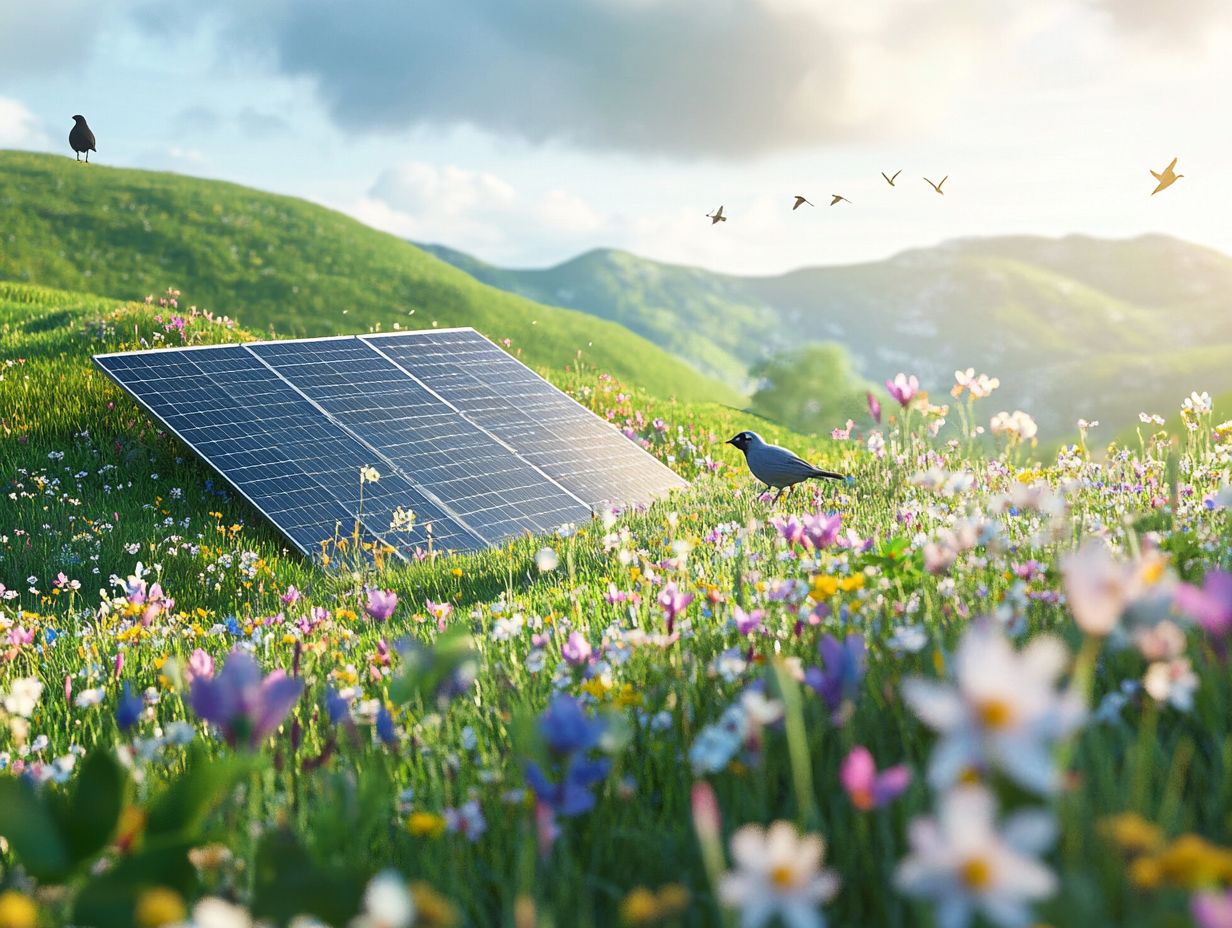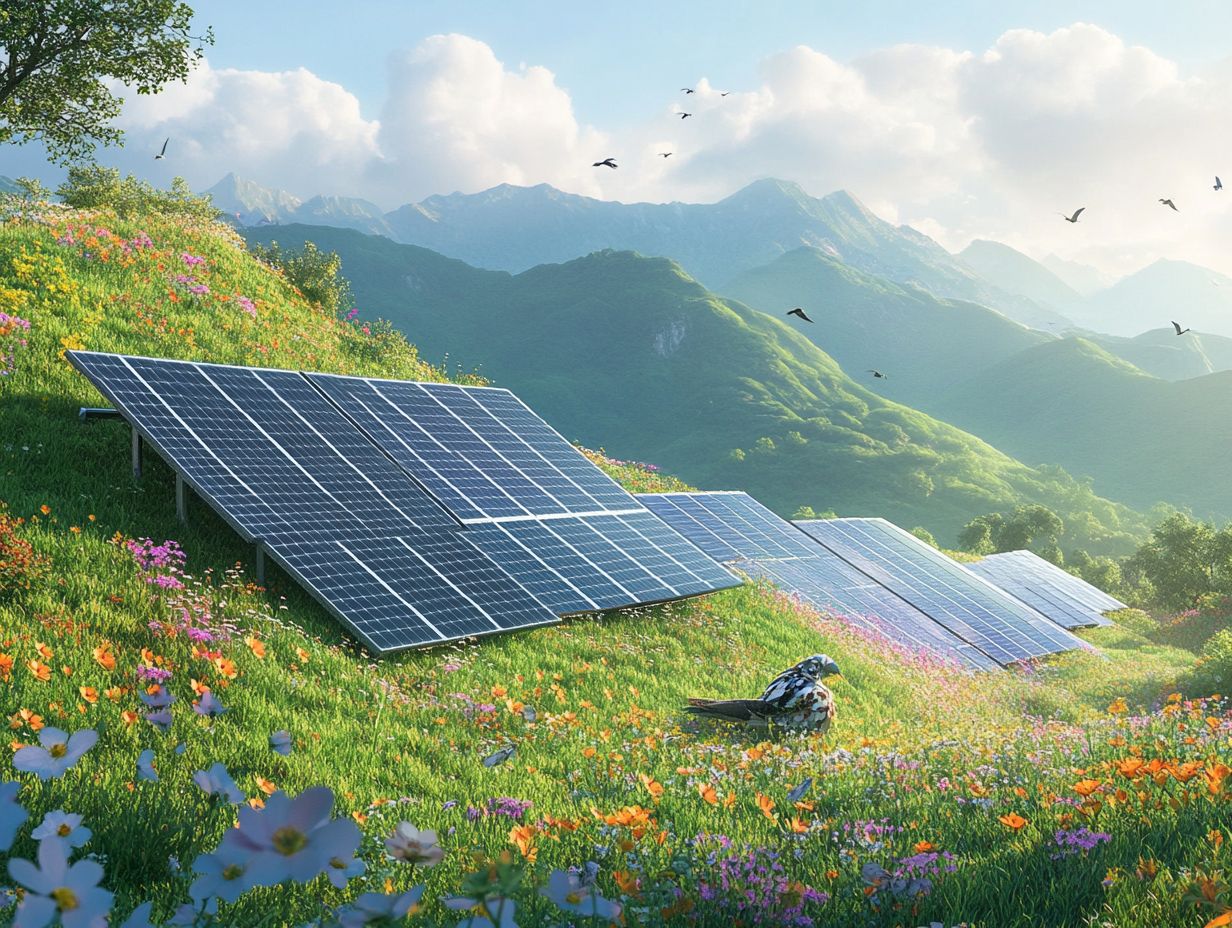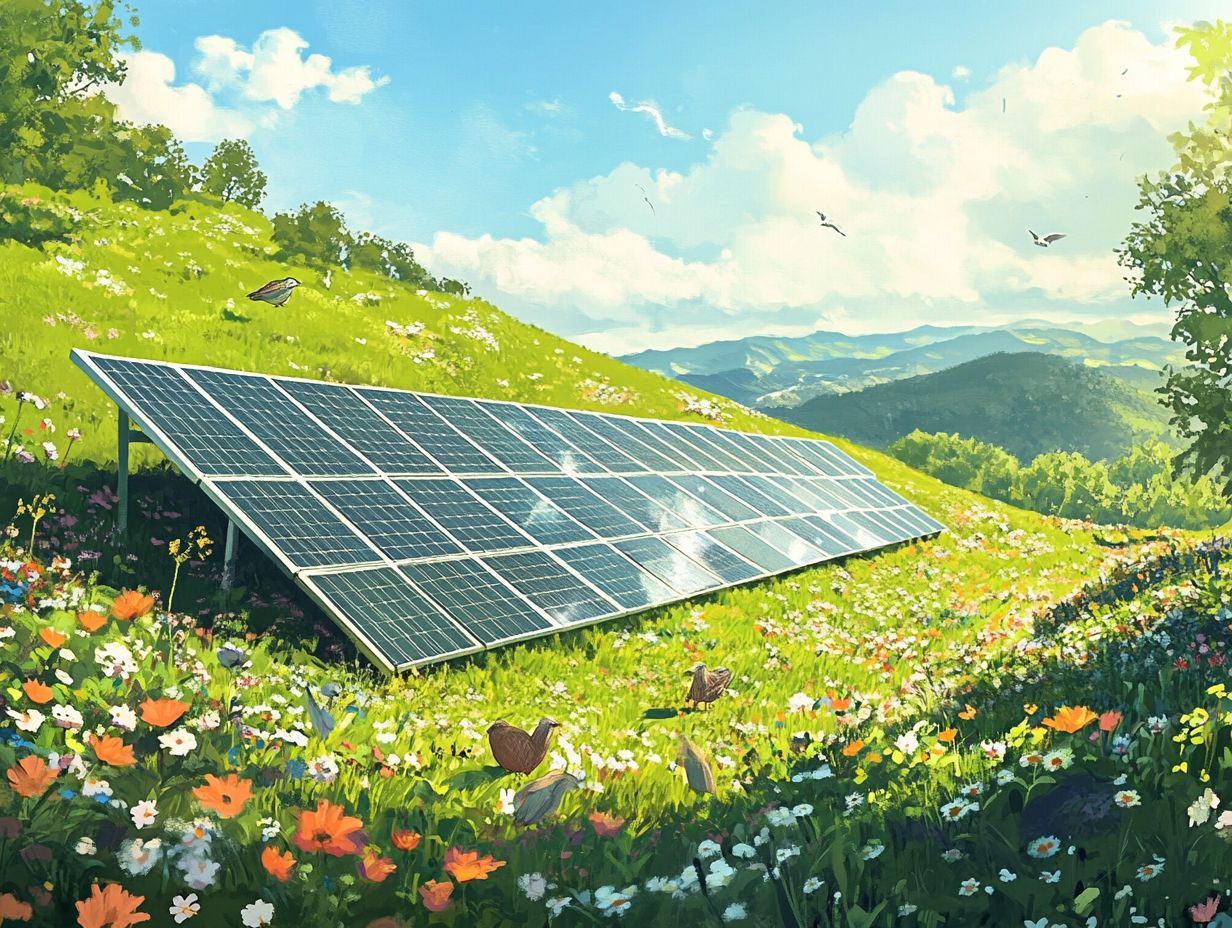As the world transitions toward renewable energy, solar panels have become a significant contributor to reducing the carbon footprint and mitigating greenhouse gas emissions.
The installation and usage of solar panels raise important considerations regarding their impact on local wildlife. This article delves into the technology behind solar panels while examining the potential disruptions to animal habitats and the behavioral changes they may provoke.
Additionally, it discusses best practices for minimizing negative effects, including solar panel design and environmental assessments, alongside the unexpected benefits that solar energy can offer to wildlife.
This exploration aims to unpack the complex relationship between solar energy and the natural world, highlighting conservation benefits and biodiversity improvement.
Key Takeaways:

The Use of Solar Panels in Renewable Energy
The growing dependence on solar panels within the renewable energy sector is reshaping the energy production landscape by providing sustainable alternatives that substantially lower greenhouse gas emissions. As countries work to address climate change and biodiversity loss, solar power plants have become an essential element in the shift toward cleaner energy sources.
This technology effectively harnesses solar energy, supporting energy requirements while also aligning with conservation strategies that safeguard wildlife habitats, enhance ecological balance, and promote wildlife protection.
Overview of Solar Panel Technology
Solar panel technology has experienced significant advancements over the years, leading to more efficient solar installations that optimize energy yields, enhance carbon sequestration, and reduce costs.
These developments include various solar panel types, such as monocrystalline, polycrystalline, and thin-film options, each designed with distinct operational mechanisms suited for different applications and environments. Monocrystalline panels, recognized for their high efficiency and aesthetic appeal, utilize single-crystal silicon, whereas polycrystalline panels, constructed from multiple silicon crystals, present a more cost-effective alternative with slightly lower efficiency.
Thin-film technology offers flexibility and lightweight characteristics, making it particularly suitable for unconventional installations. Furthermore, innovations in solar technology, including bifacial panels and advanced energy storage systems, are continually expanding the potential of solar applications, contributing to a cleaner and more sustainable future.
Effects on Local Wildlife
The establishment of solar farms introduces a range of challenges and opportunities for local wildlife. The construction and operation of solar power plants can result in habitat fragmentation and biodiversity loss, which may adversely affect various species, including desert tortoises in their natural habitats.
Potential Disruption of Habitats

The development of solar facilities can result in significant habitat disruption for local wildlife populations, raising concerns regarding habitat fragmentation, land degradation, and the long-term impacts on biodiversity.
These large-scale installations necessitate extensive land clearing and modification, disrupting the intricate networks of ecosystems that many species rely on for survival. The construction process frequently leads to the removal of native vegetation, which serves as a crucial source of food and shelter. This not only affects resident species but also migratory populations in search of suitable habitats.
Such disruption can create barriers that impede movement and breeding, potentially jeopardizing already vulnerable populations. Additionally, changes in land use can alter local climatic conditions and soil health, further complicating the ecological balance necessary to sustain diverse wildlife communities.
Impact on Animal Behavior
Solar power plants can significantly influence animal behavior, particularly regarding migratory patterns and daily activities. This influence stems from factors such as noise pollution and light pollution, which can disrupt natural rhythms.
The presence of solar installations may alter the habitats of local wildlife, resulting in changes to predator-prey dynamics, wildlife interactions, and potentially leading to declines in certain species. Additionally, understanding the impact of solar panels on local communities can help address these concerns.
For migratory birds, the reflective surfaces of solar panels may create confusion, causing disorientation during critical navigation periods. Additionally, artificial lighting at these facilities can interfere with nocturnal behaviors, affecting feeding, mating, and migration cycles.
As researchers investigate the environmental impacts of renewable energy, understanding these interactions is essential for ensuring a balanced coexistence between emerging technologies and the diverse ecosystems they affect.
Mitigating Negative Effects
To mitigate the negative effects of solar development on wildlife and local ecosystems, implementing best practices in solar facility design and habitat restoration can substantially improve wildlife conservation efforts and support environmental credits.
Best Practices for Solar Panel Placement
Implementing best practices for solar panel placement is essential to minimize environmental impacts and ensure the safety of wildlife corridors and habitat features.
By carefully considering the positioning of solar installations, organizations can protect crucial ecosystems while still achieving renewable energy goals. Key strategies include conducting thorough environmental assessments that evaluate local flora and fauna, ensuring solar panels are sited away from critical habitats. This holistic approach not only safeguards wildlife but also promotes biodiversity by maintaining natural corridors that allow animals to roam freely.
Engaging with ecologists and utilizing advanced mapping techniques can enhance decision-making processes, ultimately fostering a sustainable balance between energy needs and ecological preservation.
Alternative Energy Sources

Along with solar energy, alternative energy sources play a crucial role in enhancing biodiversity and maintaining ecological balance within local ecosystems.
Wind energy, for example, harnesses the natural power of air currents
, offering a clean alternative with minimal greenhouse gas emissions. However, it presents challenges, particularly regarding its impact on bird and bat populations, as well as local habitats.
Bioenergy, derived from organic materials, provides a means to utilize waste products. Nevertheless, its production can result in deforestation and competition for farmland, potentially disrupting species habitats.
Geothermal energy represents another viable option by tapping into the earth’s natural heat. While its environmental footprint is relatively small, the extraction process can alter local groundwater and affect surrounding ecosystems.
By evaluating these energy sources, it becomes evident that each presents distinct advantages and challenges in the pursuit of a sustainable balance that supports both energy needs and the preservation of natural habitats.
Positive Effects on Wildlife
Although there are valid concerns regarding the impact of solar energy on wildlife, it is important to recognize the positive effects as well. These include the potential for creating pollinator habitats and enhancing wildlife conservation efforts through carefully planned solar installations.
Reducing Carbon Emissions and Climate Change
One of the most significant advantages of solar energy is its capacity to reduce carbon emissions and combat climate change, thereby contributing positively to environmental health and wildlife conservation.
By utilizing the strength of the sun, solar energy systems effectively decrease reliance on fossil fuels, which are known for their greenhouse gas emissions. This transition not only reduces overall carbon footprints but also alleviates the pressure on ecosystems that have already been affected by climate change.
Promoting renewable energy sources like solar energy plays a crucial role in protecting vital wildlife habitats, as it supports the conservation of areas that might otherwise suffer from traditional energy extraction methods. Ultimately, the utilization of solar technology fosters healthier ecosystems, preserves biodiversity, and enables wildlife to thrive in their natural environments.
Creating New Habitats for Wildlife
Solar developments have the potential to create new habitats for wildlife, offering opportunities for habitat restoration and supporting ecosystem services such as carbon sequestration and biodiversity improvement.
As solar farms transform the landscape, they often integrate native vegetation and low-impact landscaping, which can promote diverse ecosystems. The intentional design of these areas facilitates the coexistence of renewable energy generation and wildlife, fostering habitats for birds, pollinators, and small mammals.
These practices enhance biodiversity, enabling various species to thrive in a more sustainable environment. By incorporating wildlife corridors and planting diverse flora and considering pollinator habitats, solar farms can minimize disruption to existing ecosystems, preventing biodiversity loss, while actively contributing to wildlife conservation efforts.
Consequently, these initiatives support clean energy objectives and serve as vital components in the preservation of natural habitats.
Frequently Asked Questions on Solar Energy Impacts

What is the impact of solar panels on local wildlife and habitats?
Solar panels have a minimal impact on local wildlife, as they do not emit any harmful chemicals or byproducts. In fact, solar energy is a more sustainable and eco-friendly alternative to traditional forms of energy production, which can have a negative impact on wildlife habitats.
Do solar panels harm birds or other animals?
In rare cases, solar panels can pose a threat to birds and other animals if they are not installed properly. However, with proper installation and maintenance, the risk of harm to wildlife is extremely low. Additionally, the positive impact of solar energy on the environment and renewable energy goals far outweigh any potential negative impact on wildlife, including construction impacts.
Do solar panels affect the behavior of local wildlife?
There is no evidence that solar panels have a significant impact on the behavior of local wildlife, wildlife populations, and animal habitats. Animals may be curious about the panels at first, but they quickly learn to avoid them. Some studies have even shown that wildlife may be attracted to solar panel arrays as they can provide shade and shelter.
Can solar panels be harmful to insects?
Solar panels do not produce any harmful emissions or chemicals that can harm insects. In fact, solar energy can have a positive impact on insect populations, as it reduces the need for pesticides and other harmful chemicals used in traditional energy production. Additionally, solar panels provide shade and cooler microclimates that can benefit certain insect species, supporting ecological balance.
Are there any measures taken to protect wildlife when installing solar panels?
Yes, there are many measures that can be taken to protect wildlife and mitigate habitat fragmentation when installing solar panels. These include proper site selection, using eco-friendly materials, and implementing bird and animal deterrents, while considering solar panel design that minimizes light pollution and noise pollution. Many solar panel companies also work with wildlife experts to ensure their installations do not disrupt local habitats, preserving native plants and promoting habitat restoration.
How can I help protect local wildlife while using solar energy?
There are several ways you can help protect local wildlife while using solar energy and understanding its environmental impacts. These include choosing a reputable solar panel company that uses environmentally friendly practices, properly maintaining your solar panel system to avoid any potential hazards, and supporting initiatives that promote sustainable energy solutions that enhance ecosystem services and conservation strategies.






